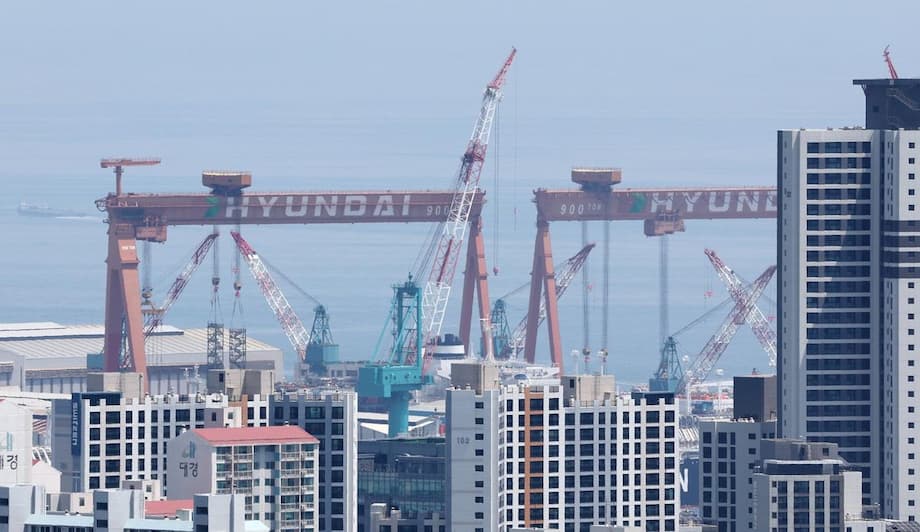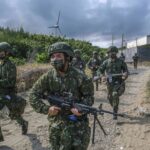Inside Koreas manufacturing heartland
Foreign labor keeps the factories, refineries, and shipyards of Koreas southeast moving. Fresh data show how central these workers are to the regional economy and how they are faring. In Busan, Ulsan, and South Gyeongsang, nearly 60 percent of foreign workers are in mining and manufacturing, and they take home an average of 30 million won a year, about 21,400 dollars at recent exchange rates. The region is home to heavy industry that powers national exports, so the profile of its foreign workforce skews toward production jobs that run around the clock.
- Inside Koreas manufacturing heartland
- Who is coming to the southeast
- Why factories rely on migrant labor
- Inside the Employment Permit System
- Paychecks and the cost of living
- Risks on the job and off the clock
- Integration beyond the factory gate
- Beyond factories, the care labor debate grows
- What would help foreign workers and local employers
- Key Points
That industrial footprint is large. A central bank study estimated the southeast produces 40.8 percent of the countrys automobiles, 27.7 percent of auto parts, 79.3 percent of ships, and 47.5 percent of refined petroleum products. The roots go back decades. Ulsan hosted the first industrial complex in 1962. As the country shifted from light industry to heavy and chemical sectors in the 1970s, export oriented complexes multiplied in port cities including Pohang and Busan. Those plants still need a stable flow of line workers, welders, mechanics, and logistics crews, and many of those jobs are now filled by migrants.
The southeast counted about 215,000 foreign residents last year. South Gyeongsang held the largest share with 117,000, followed by Busan with 63,000 and Ulsan with 34,000. In 2023, 97,972 foreigners aged 15 or older had jobs in the region. Regular employment dominates. 76.8 percent work as permanent, full time employees, with day laborers at 12.7 percent and the self employed at 10.5 percent. By sector, foreign workers in business, personal and public services average 31 million won a year, those in mining and manufacturing average 30 million won, and those in construction average 25 million won. Thirty million won translates to roughly 2.5 million won per month before taxes and deductions, with overtime and shift work raising pay in many plants.
Despite pressures that come with factory schedules and life far from home, self reported satisfaction is relatively high. In 2024, about 75.2 percent said they were satisfied with their jobs and 65 percent were satisfied with income. Overall life satisfaction in Korea reached 83.2 percent. The biggest reported challenge was language, cited by 37.4 percent. About 26.9 percent reported no particular difficulty while 17 percent pointed to loneliness, a reminder that paychecks are only part of the story of migration.
Who is coming to the southeast
The foreign population in the region is young and mostly male, reflecting the types of jobs on offer. Men make up 64.6 percent of foreign residents and women 35.4 percent. People in their 30s are the largest age group at 32.3 percent, followed by those in their 20s at 29.5 percent and those in their 40s at 14.8 percent. These are prime working ages for long shifts and physically demanding roles in metalworking, shipbuilding, auto assembly, and petrochemicals.
By nationality, Vietnamese workers form the single largest group at 22.2 percent. Ethnic Koreans with Chinese nationality account for 12.4 percent, and other Chinese nationals account for 7.6 percent. Vietnamese migration has grown in step with factory needs, business and education links, and people to people networks that now stretch from port cities in Vietnam to industrial zones in Korea. Chinese communities, including ethnic Koreans from China, have long supplied workers to small manufacturers and service firms, helped by language familiarity and established social networks.
The concentration in heavy industry shapes daily life. Many recruits join through group hiring, live in dormitory style housing near plants, and rely on colleagues for information about banking, remittances, health care, and navigating local services in Busan, Ulsan, Changwon, and smaller industrial towns in South Gyeongsang.
Why factories rely on migrant labor
Two forces support the demand for foreign workers in the southeast. First, the country faces a shrinking and aging population, which reduces the pool of young applicants willing to take physically taxing work on rotating shifts. Second, the regional economy depends on export driven production that requires reliable staffing across dense supplier networks. Large brands anchor shipyards, car plants, and refineries, but thousands of small and medium sized firms make components and handle maintenance. Many of those firms report chronic vacancies and rely on migrant hiring to meet orders.
Policy also matters. The Employment Permit System (EPS) was introduced to match labor shortages at small and medium sized companies with legally recruited foreign workers. The EPS uses government to government agreements, standardized contracts, and screening to bring in workers for manufacturing, construction, agriculture, fisheries, and certain services. A key design feature is that recruited workers are covered by the same basic labor laws as citizens, including pay, overtime, industrial safety, and social insurance participation.
This architecture steers most recruits into formal payroll positions, which helps explain the high share of regular employment among foreign workers in the southeast. Production jobs in shipbuilding, automotive parts, and petrochemicals rely on training and team routines, so firms benefit from retaining staff for multi year contracts rather than relying on day to day hiring.
Inside the Employment Permit System
The EPS manages recruitment in sending countries through public agencies, with caps on fees and standardized processes. Applicants typically complete language and skills screening, are matched to employers, and receive pre departure orientation about labor rights and workplace norms. Once in Korea, workers sign contracts that spell out base pay, hours, overtime, accommodations, and insurance. Many receive safety training and plant specific instruction before starting work.
Reform has gradually widened worker protections. Compared with agent based systems in parts of Asia, the EPS has reduced recruitment costs and given workers access to formal complaint channels. Labor laws on minimum wage, overtime pay, rest days, and injury compensation cover EPS employees. Job mobility has been a sensitive issue, but policy changes have allowed moves in defined cases, such as business closures, unpaid wages, or proven abuse. That can help reduce the power imbalance that occurs when a visa is tied to a single employer.
Effective oversight still depends on enforcement. When inspections are frequent and disputes are resolved quickly, confidence in the system rises. When enforcement lags, some workers still face pressure to accept unpaid hours or unsafe conditions. Language support during safety briefings and grievance procedures makes a difference, especially for employees handling heavy equipment or hazardous materials in refineries and shipyards.
Paychecks and the cost of living
An average annual income of 30 million won equals roughly 2.5 million won per month before taxes. Take home pay varies by plant, skill level, and shift premiums. Many factories operate nights and weekends, which can add overtime earnings. Short term bonuses to retain staff during peak order cycles also boost pay in some firms, while smaller workshops may offer lower base wages with longer hours.
Living costs in the southeast are lower than in Seoul, but budgets are tight for those supporting family members abroad. Company dormitories reduce housing costs and commute times, yet they can be crowded and are often located in industrial zones far from city centers. Workers who rent on the private market must account for deposits and rent or monthly room fees. Transportation, remittances, and food costs add up. Many migrants prioritize sending a large share of income home, which shapes choices about accommodation, leisure, and travel.
Sector pay gaps are visible in the regional data. Foreign workers in business, personal and public services earn around 31 million won on average, those in mining and manufacturing earn 30 million won, and those in construction earn 25 million won. The ranking reflects differences in skill requirements, overtime patterns, and contract structures. A service job in a hospital support unit or logistics office may carry steadier hours and slightly higher base pay. A construction role can be seasonal and sensitive to project delays, which reduces annual totals.
Risks on the job and off the clock
Factory and construction work carries real hazards, from falls to machinery accidents and exposure to heat or chemicals. Migrant workers face higher risk when safety training is hard to follow or when protective gear is not supplied. A gap between what is taught in the local language and what a newcomer understands can turn routine tasks into danger. Stronger translation in safety briefings and on equipment labels reduces that risk.
Wage theft and abusive schedules persist in some workplaces. When employers delay or withhold pay, the law offers remedies through labor offices and the courts, but many workers are reluctant to complain if they fear retaliation or visa problems. Employer provided housing can also be substandard, including container units and crowded rooms. Clear housing standards and audits can improve conditions without waiting for complaints.
Irregular workers who fall outside the EPS, including people who overstay short visits or shift into off the books jobs in agriculture or construction, are especially vulnerable. They lack basic protections and often avoid hospitals or government offices. Expanding legal channels where demand is predictable, improving monitoring of job brokers, and encouraging anonymous reporting of abuses would reduce the space for exploitation.
Integration beyond the factory gate
Language is the single biggest obstacle reported by foreign workers in the southeast, with 37.4 percent calling it their top challenge. That finding aligns with what employers and community groups see. Workplaces that invest in basic Korean classes, multilingual signage, and interpretation during training reduce errors and improve morale. Local governments and civic groups also run evening courses that help workers manage daily tasks such as banking, health care appointments, and public transport.
Loneliness ranks third at 17 percent, a real strain for people working long shifts far from family. Community centers, sports clubs, and faith based groups offer support networks. Access to mental health counseling in multiple languages matters too, especially for night shift workers who struggle to find daytime services.
Diet and health change after migration. A study of Southeast Asian workers in Korea found a shift toward more kimchi and seaweed and more coffee and pizza, with less fresh fruit and fewer homemade meals. About 28.2 percent reported worse health after arrival, often citing difficulty adjusting to new foods, more instant meals, and less exercise. Employers and local health centers can help with orientation on nutrition, affordable local produce, and ways to stay active on irregular schedules.
Beyond factories, the care labor debate grows
An aging society and a shortage of care workers have pushed policymakers to test new migration channels outside manufacturing. Seoul launched a pilot program that brought in a first group of foreign household helpers to ease childcare and domestic workloads, with plans to expand recruitment and add more Southeast Asian countries. Early feedback has included concerns about low pay, deductions for lodging, unclear job definitions, and retention, as some recruits found better wages in other sectors.
Unions and civic groups have argued that trying to fix the care gap with cheaper migrant labor risks undermining standards. Advocates call for clearer contracts, guaranteed minimum wage coverage, and transparent work hours. Policymakers are still debating the right balance between affordability for families and fair terms for workers. The outcome matters for cities across the country, including the southeast, where demand for elder care is rising alongside factory needs.
Any expansion of migration into care work will draw on lessons from manufacturing. Government managed recruitment, equal application of labor law, language support, and realistic oversight are pillars that have improved outcomes for factory hires. Those same features can prevent churn and protect families and workers in the home care market.
What would help foreign workers and local employers
Several low cost changes would improve life and productivity. First, expand language access at the workplace. Short daily modules tied to tasks and better translation of safety rules can cut accidents and scrap rates. Second, make it easier to change jobs in cases of nonpayment or documented harassment. Faster transfer approvals reduce the leverage that abusive bosses hold over visa holders. Third, set practical housing standards for company provided rooms and check them during regular inspections.
Fourth, ensure every recruit is enrolled in the right insurance, including industrial accident coverage and national health insurance where eligible. Fifth, invest in community integration, from weekend language classes to legal clinics and financial literacy. City and provincial programs in Busan, Ulsan, and South Gyeongsang can coordinate with employer groups to fund shared training hubs that small suppliers can use. Finally, tighten oversight of recruiters at home and abroad, with real penalties for illegal fees. Government to government hiring has already reduced costs in Korea compared with agent run systems in parts of Asia. Keeping that channel clean protects workers and keeps labor supply steady for factories that need it.
Key Points
- About 59.2 percent of foreign workers in Koreas southeast are in mining and manufacturing, reflecting the regions heavy industry base.
- Average annual income for foreign workers in the region is about 30 million won, with services at 31 million, manufacturing at 30 million, and construction at 25 million.
- The region hosts roughly 215,000 foreign residents, with South Gyeongsang the largest hub, followed by Busan and Ulsan.
- Regular employment is common, with 76.8 percent of foreign workers on permanent full time contracts.
- Self reported satisfaction is high, but 37.4 percent cite language as the biggest difficulty and 17 percent cite loneliness.
- Vietnamese workers are the largest national group at 22.2 percent, followed by ethnic Koreans with Chinese nationality at 12.4 percent.
- The Employment Permit System channels recruits into formal jobs with basic labor protections and lower recruitment fees than agent based systems.
- Safety risks, wage disputes, and substandard housing persist in some workplaces, and irregular workers remain especially vulnerable.
- Policy debates are widening to include care work, with pilot programs testing foreign household helpers and calls for stronger protections.




